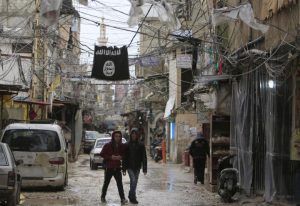The recent clashes in the Ain el-Hilweh Palestinian refugee camp in southern Lebanon revealed security pockets that extremists have taken up as safe havens and that are harboring fugitives wanted by Lebanese authorities, like reported by aawsat.com .
They also revealed dozens of non-Lebanese fugitives whose affiliations range from local extremist groups to others active in Syria and Iraq, such as ISIS.
Even though the security at the volatile camp was, for a short while, controlled by Palestinian factions in cooperation with the Lebanese state, the emergence of organizations and individuals who are loyal to al-Qaeda and ISIS has contributed to the creation of security pockets in the camp. These pockets are becoming a burden on the residents and have led to the deterioration of the security situation, which results in armed clashes that erupt there from time to time.
The emergence of extremists in Ain el-Hilweh, which is located on the outskirts of the southern city of Sidon, soon gave way to the emergence of groups, whose members had joined the fighting in Syria and Iraq. The extremist groups in Syria have drawn youths from Ain el-Hilweh, who had joined the ranks of ISIS and al-Nusra Front. It was revealed that in 2016 that more than six people from the camp had been killed in fighting alongside fundamentalist groups in Syria.
Since 2012, 62 youths from various camps throughout Lebanon had joined extremist groups in Syria, revealed Palestinian security figures. Around 50 of them have since been killed in various battles there.
Once safe passage to Syria and Iraq was no longer available, would-be extremists have sought refuge in Ain el-Hilweh, raising security fears in the camp after Lebanese security agencies were informed that sympathy for ISIS was growing among them, especially after some of those who had fought with the extremist group in Syria had returned to the camp. Estimates say however that the number of these sympathizers is not high and has grown limited after the Lebanese army intelligence’s arrest in September of Imad Yassine, head of the Usbat al-Ansar group that had sworn allegiance to ISIS.
Debate on the presence of ISIS in Ain el-Hilweh began to take a serious turn in 2015 in wake of statements made by Interior Minister Nouhad al-Mashqnouq after the twin suicide bombings in the Jabal Mohsen neighborhood in the northern city of Tripoli in January of that same year. The minister spoke of a new “zone of death” for ISIS in Lebanon that starts from the border region of Arsal, Ain el-Hilweh and Roumieh Prison in Lebanon and extends to Iraq and Syria.
ISIS has meanwhile not announced its official presence in Lebanon, but it is instead apparently relying on other extremist groups, such as al-Shabab al-Muslim, that includes members of the Fatah al-Islam organization that had waged battles with the Lebanese army in the Palestinian refugee camp of Nahr al-Bared in 2007. Prominent Palestinian sources in Ain el-Hilweh said however that the actual number of ISIS members or those who had sworn allegiance to it is very low. It has far more sympathizers than actual members, they explained.
The emergence of ISIS in Ain el-Hilweh has affected the influence of Islamist organizations that had been active in the camp. The camp, traditionally, is subject to the control of the Fatah movement that has the strongest presence on the ground. It is followed by the Hamas group. Other factions include the Islamic Jihad and Palestinian Liberation Front.
Extremist groups include Usbat al-Ansar and al-Shabab al-Muslim, whose members support ISIS and al-Nusra Front.
With time, these fundamentalist groups have started to adhere to other extremist groups that are following foreign agendas. They have also grown powerful enough to control whole neighborhoods in Ain el-Hilweh, therefore posing a security dilemma to the Palestinian factions. These neighborhoods have become a safe haven for fugitives who are wanted by Lebanese authorities. Among these fugitives is former singer Fadel Shaker, who is wanted for taking part in battles against the army in Sidon in 2013, and Shadi al-Mawlawi, who is accused of belonging to terrorist groups and taking part in fighting in Tripoli in 2012.
There are around 20 Lebanese fugitives in Ain el-Hilweh, revealed Palestinian Liberation Front politburo member Salah al-Youssef, while there are around 150 non-Lebanese, mainly Palestinian, fugitives who belong to the terrorist groups of Jund al-Sham, Fatah al-Islam and al-Qaeda. Lebanese authorities recently said over 54 Lebanese fugitives are in the camp, most of whom are involved in terror attacks that have targeted the army and civilians in Sidon, Beirut and Tripoli.
The Lebanese fugitives have also become a burden on the camp, with some extremist factions demanding that they turn themselves over to the Lebanese authorities. This development emerged in light of a Lebanese-Palestinian agreement that was reached after the latest round of clashes between Fatah and extremist groups in Ain el-Hilweh earlier this year. The deal calls for turning all Lebanese fugitives in the camp over to Lebanese authorities.



